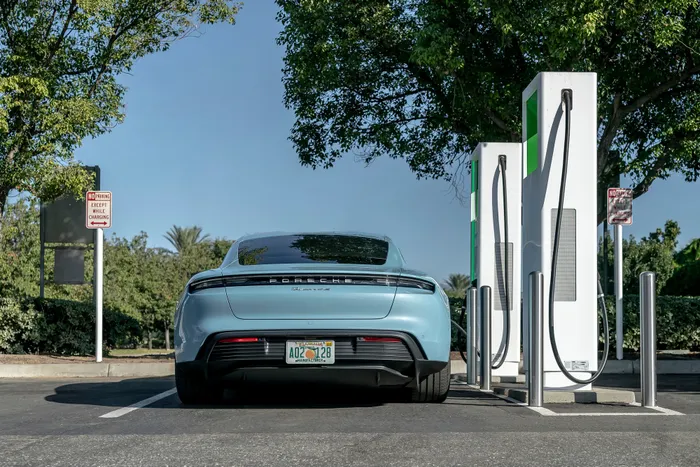Edmunds tests show why electric car ranges can differ from official figures

A Porsche Taycan charging up. Picture: AP.
SANTA MONICA, CALIFORNIA - You’ve probably heard the phrase “your mileage may vary” with regard to how your real-world fuel economy compares to the manufacturer estimate. The adage refers to petrol-powered vehicles, but the same applies to electric cars.
However, US automotive authority Edmunds has found that the variance can be even greater with an electric vehicle, depending on the vehicle.
After owning and testing many of the popular EVs on the roads today, Edmunds created its own standardised real-world test to provide an additional data point for comparison. A closer look at its tests for the Porsche Taycan and the Tesla Model Y Performance turned up some interesting results.
The 2020 Porsche Taycan 4S was way off from the EPA estimated 326km of range in Edmunds’ real-world driving test. Edmunds observed 520km and saw a better energy consumption of 32.3 kilowatt-hours of electricity used every 160km of driving, versus the EPA’s 49 kWh/160km.

In contrast, the 2020 Tesla Model Y Performance with 21-inch wheels - the brand’s newest small SUV - did exceptionally well in the EPA’s test, where it earned an estimated 468km and a power consumption rating of 28 kWh/100 miles, using the maximum range mode. While Edmunds saw comparable efficiency in its real-world test, at 28.4 kWh/100 miles, the overall range result of 407km was slightly lower than the EPA estimate.
So why the difference?
Testing variances
Many factors come into play. The EPA in the US has five test or drive cycles that simulate road routes and determine how efficiently a car will perform in different scenarios. But the EPA only requires carmakers to use two. Porsche, like many other manufacturers, opts for the two-cycle test because of the added prep time and costs involved in completing the others. Going this route automatically reduces the Porsche’s potential range by 30 percent, a larger penalty than if the carmaker had chosen the five-cycle test as Tesla did.
Alternative drive modes not tested
Another thing working against the Porsche in its EPA test is its default drive mode. If a vehicle has a more efficient operating mode - but it’s not the default drive mode - it won’t be employed in the test, which could significantly impact energy use. The Taycan has a Range mode, for example, that makes various adjustments to improve energy consumption without any dramatic loss in daily driving performance.
Edmunds’ experts typically engage these energy-saving drive modes since they are commonly used by EV drivers.
Braking style matters
Additionally, since Porsche wants the Taycan to drive like other Porsche models, it tunes the Taycan’s regenerative braking differently than Tesla does. The default setting is low regenerative braking, which means the Taycan coasts when you lift off the accelerator. Porsche says when the driver presses the brake pedal, regenerative braking is occurring but there is a window during that stop where the actual brakes come into play to halt the car.
Tesla maximises regenerative braking in its default drive mode, leaving the lighter coasting setting as an option. This means that when you lift off the accelerator in a Model Y, it immediately begins to slow and recoup that energy. Many seasoned EV drivers prefer this approach since you can often get by without ever touching the brake pedal, which helps maximize the efficiency of each stop.
Max battery usage
A key difference between Tesla and other companies is that it makes more of its battery available for use. Electric vehicle batteries that are constantly charged to their maximum capacity tend to degrade quicker over time, so manufacturers including Porsche place stricter limits on charging and use. Tesla leaves it up to the owner’s discretion and simply recommends that the max battery charge only be used for longer trips. Otherwise, it says owners should use a charge of around 90 percent for daily use.
The 90 percent charge is what Edmunds followed for its Model Y test as, again, it represents how the majority of Tesla drivers will use their car. Extrapolated out, Edmunds estimates that charging the Y’s battery to its maximum capacity would have added 40km to its as-tested range.
Edmunds says: Range isn’t everything, but it’s still an important number for many EV owners and those considering an EV. So it’s important to understand how and why some EVs may perform better or worse than their EPA estimates.
* This story was provided to The Associated Press by the automotive website Edmunds.
AP
Related Topics: